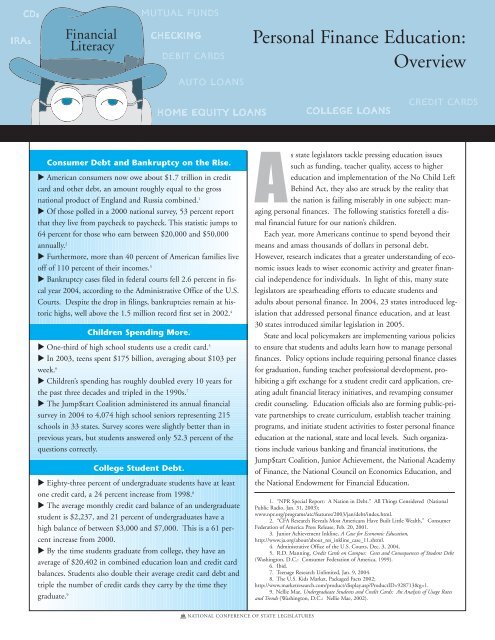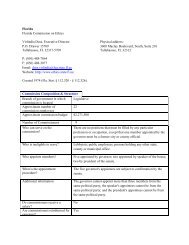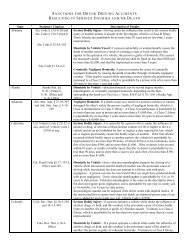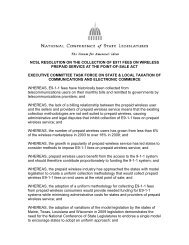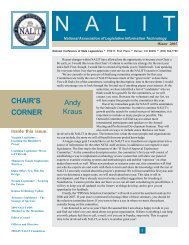Printer Friendly Version - National Conference of State Legislatures
Printer Friendly Version - National Conference of State Legislatures
Printer Friendly Version - National Conference of State Legislatures
You also want an ePaper? Increase the reach of your titles
YUMPU automatically turns print PDFs into web optimized ePapers that Google loves.
Consumer Debt and Bankruptcy on the Rise.<br />
American consumers now owe about $1.7 trillion in credit<br />
card and other debt, an amount roughly equal to the gross<br />
national product <strong>of</strong> England and Russia combined. 1<br />
Of those polled in a 2000 national survey, 53 percent report<br />
that they live from paycheck to paycheck. This statistic jumps to<br />
64 percent for those who earn between $20,000 and $50,000<br />
annually. 2<br />
Furthermore, more than 40 percent <strong>of</strong> American families live<br />
<strong>of</strong>f <strong>of</strong> 110 percent <strong>of</strong> their incomes. 3<br />
Bankruptcy cases filed in federal courts fell 2.6 percent in fiscal<br />
year 2004, according to the Administrative Office <strong>of</strong> the U.S.<br />
Courts. Despite the drop in filings, bankruptcies remain at historic<br />
highs, well above the 1.5 million record first set in 2002. 4<br />
Children Spending More.<br />
One-third <strong>of</strong> high school students use a credit card. 5<br />
In 2003, teens spent $175 billion, averaging about $103 per<br />
week. 6<br />
Children’s spending has roughly doubled every 10 years for<br />
the past three decades and tripled in the 1990s. 7<br />
The Jump$tart Coalition administered its annual financial<br />
survey in 2004 to 4,074 high school seniors representing 215<br />
schools in 33 states. Survey scores were slightly better than in<br />
previous years, but students answered only 52.3 percent <strong>of</strong> the<br />
questions correctly.<br />
College Student Debt.<br />
Eighty-three percent <strong>of</strong> undergraduate students have at least<br />
one credit card, a 24 percent increase from 1998. 8<br />
The average monthly credit card balance <strong>of</strong> an undergraduate<br />
student is $2,237, and 21 percent <strong>of</strong> undergraduates have a<br />
high balance <strong>of</strong> between $3,000 and $7,000. This is a 61 percent<br />
increase from 2000.<br />
By the time students graduate from college, they have an<br />
average <strong>of</strong> $20,402 in combined education loan and credit card<br />
balances. Students also double their average credit card debt and<br />
triple the number <strong>of</strong> credit cards they carry by the time they<br />
graduate. 9<br />
NATIONAL CONFERENCE OF STATE LEGISLATURES<br />
Personal Finance Education:<br />
Overview<br />
As state legislators tackle pressing education issues<br />
such as funding, teacher quality, access to higher<br />
education and implementation <strong>of</strong> the No Child Left<br />
Behind Act, they also are struck by the reality that<br />
the nation is failing miserably in one subject: managing<br />
personal finances. The following statistics foretell a dismal<br />
financial future for our nation’s children.<br />
Each year, more Americans continue to spend beyond their<br />
means and amass thousands <strong>of</strong> dollars in personal debt.<br />
However, research indicates that a greater understanding <strong>of</strong> economic<br />
issues leads to wiser economic activity and greater financial<br />
independence for individuals. In light <strong>of</strong> this, many state<br />
legislators are spearheading efforts to educate students and<br />
adults about personal finance. In 2004, 23 states introduced legislation<br />
that addressed personal finance education, and at least<br />
30 states introduced similar legislation in 2005.<br />
<strong>State</strong> and local policymakers are implementing various policies<br />
to ensure that students and adults learn how to manage personal<br />
finances. Policy options include requiring personal finance classes<br />
for graduation, funding teacher pr<strong>of</strong>essional development, prohibiting<br />
a gift exchange for a student credit card application, creating<br />
adult financial literacy initiatives, and revamping consumer<br />
credit counseling. Education <strong>of</strong>ficials also are forming public-private<br />
partnerships to create curriculum, establish teacher training<br />
programs, and initiate student activities to foster personal finance<br />
education at the national, state and local levels. Such organizations<br />
include various banking and financial institutions, the<br />
Jump$tart Coalition, Junior Achievement, the <strong>National</strong> Academy<br />
<strong>of</strong> Finance, the <strong>National</strong> Council on Economics Education, and<br />
the <strong>National</strong> Endowment for Financial Education.<br />
1. “NPR Special Report: A Nation in Debt.” All Things Considered (<strong>National</strong><br />
Public Radio, Jan. 31, 2003);<br />
www.npr.org/programs/atc/features/2003/jan/debt/index.html.<br />
2. “CFA Research Reveals Most Americans Have Built Little Wealth,” Consumer<br />
Federation <strong>of</strong> America Press Release, Feb. 20, 2001.<br />
3. Junior Achievement Inkline, A Case for Economic Education,<br />
http://www.ja.org/about/about_res_inkline_case_11.shtml.<br />
4. Administrative Office <strong>of</strong> the U.S. Courts, Dec. 3, 2004.<br />
5. R.D. Manning, Credit Cards on Campus: Costs and Consequences <strong>of</strong> Student Debt<br />
(Washington, D.C.: Consumer Federation <strong>of</strong> America, 1999).<br />
6. Ibid.<br />
7. Teenage Research Unlimited, Jan. 9, 2004.<br />
8. The U.S. Kids Market, Packaged Facts 2002;<br />
http://www.marketresearch.com/product/display.asp?ProductID=928713&g=1.<br />
9. Nellie Mae, Undergraduate Students and Credit Cards: An Analysis <strong>of</strong> Usage Rates<br />
and Trends (Washington, D.C.: Nellie Mae, 2002).


